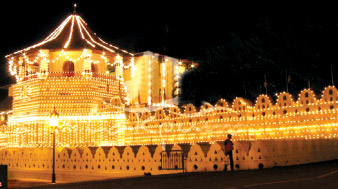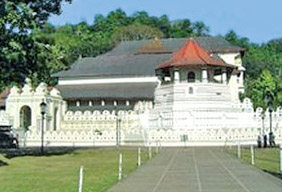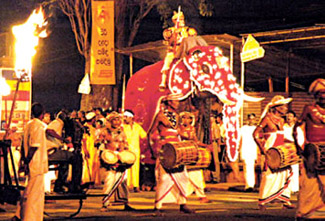|

A spectacular pageant
“The Kandy Perahera is a religious festival. The Buddha’s Tooth Relic
is taken in the perahera. The place where the Tooth Relic is kept is
called the Dalada Maligawa. The Diyawadana Nilame is the guardian of the
Dalada Maligawa and is an important person in the procession. The
procession of the four devalas - Vishnu, Natha, Kataragama and Pattini
join the Kandy Perahera.”
 This paragraph is from the lesson titled festivals in the Grade 6
Pupil’s Work Book (Page 49). This is incorrect. The procession of the
four devala does not join the Kandy perahera; they are a part of the
Kandy perahera. This paragraph is from the lesson titled festivals in the Grade 6
Pupil’s Work Book (Page 49). This is incorrect. The procession of the
four devala does not join the Kandy perahera; they are a part of the
Kandy perahera.
The Kandy perahera is an amalgam (combination) of the Dalada or
Maligawa perahera and the peraheras of the four devalas. They are
separate processions (not procession as in the book) of the four devalas,
Natha, Vishnu, Kataragama and Pattini in that order, not Vishnu, Natha.

Sathara Devala
In common parlance (way of speaking) this grand annual pageant is the
Kandy perahera; but, in fact, it is the Esala perahera held from the
time Senkadagala Nuwara became the ‘Maha Nuwara’ (capital) of the
Sinhala Kingdom. Robert Knox who was kept a prisoner by King Rajasingha
II for twenty years from 1660-1679, has recovered that “a solemn feast
was celebrated in the city of Kandy in the month of June-July”.This
feast or festival was started long before Knox’s time.
Kandy’s Esala Perahera was originally the “Satara Devala” (four
devala) perahera and the finale of the Esala Mangalla held throughout
the Sinhala kingdom. The Esala Mangalla is a festival in honour of a
particular god or gods and a devala is the venue of the festival. Some
of these festivals are the Ruhunu Kataragama Esala festival in honour of
God Kataragama (Deviyo ), and the Devinuwara festival in honour of God
Vishnu. At Munneswaram the festival is in honour of God Ishvara, at
Nallur-God Kandasamy and Goddess Pattini at Nawagamuwa.
It was only in 1752/53 that the Dalada or Maligawa perahera was added
to the Satara Devala perahera. It was done on a suggestion of Upali
thero who had come from Siam (now Thailand) to confer the Upasampada
(higher ordination on the Sinhala bhikkhus. Watching the Satara Devala
perahera the thero felt sad that the Buddha had no place and he told
this to Saranankara Sangharaja who conveyed it to the king. Keerthi Sri
Rajasinghe then gave an order that henceforth the perahera should be led
by the Maligawa perahera carrying the Sacred Tooth Relic for public
veneration. Munkotuway Rala sums up the order of the peraher in the
narrative poem Sangharaja Vata. Natha Devala procession follows the
Maligawa perahera, taking precedence over Vishnu Devala, as Natha is
 the
guardian God of Maha Nuwara and is said to be an incarnation of Maitri
Bodhisatva. the
guardian God of Maha Nuwara and is said to be an incarnation of Maitri
Bodhisatva.
The composition of the perahera has changed over the years. When Dr.
John Davy, physician to the British Governor saw the perahera in the
last days of the Sinhala kingdom, the king, queen and ladies of the
court went in the procession.
Now, there are women only in the Pattini Devala Perahera.In the 1930,
a Japanese monk walked in the procession beating his own drum. Now rows
and rows of young men dressed in white carrying Buddhist flags are part
of the perahera. Some folk dances like the ‘Kulu’ (winnowing fan) dance
by women have also been introduced.

Rites
Although the composition of the perahera has changed over the years,
the rites haven’t changed and the perahera starts sharp at the
auspicious time. No waiting for MPs and VIPs to arrive to place the
Relic Casket on the elephant, as so often happens in low-country
perahera. The rites are meticulously (with great care to details)
followed. The first is the planting of the ‘kap’ - the sacred post -
with which the festival begins. The other is the diya kapeema’ which
brings the festival to its close.
Sumana Saparamadu
***********
Planting of Kap
(Kap Situveema)
The planting of the Sacred post is the first rite. On an auspicious
day before the new moon - the chief lay officials of each devala - the
Basnayaka Nilame - assemble under a young jak tree that has borne no
fruit and has a trunk of a certain girth. It is fumigated with burning
resin - dummala - and smeared with a preparation of sandalwood. Nine
lamps and nine flowers are placed on nine betel leaves and placed at the
foot of the tree as offerings. Then, the tree is felled by a woodcutter
dressed in white, who has earlier purified himself by sprinkling lime
juice on his body.
The woodcutter divides the trunk into four equal parts and each part
is carried to the devalas led by tom-tom beaters. On the day of the new
moon, this piece of consecrated wood is planted in the devala grounds.
It is protected by a roof and is covered and ornamented with tender
coconut palm leaves, flowers and fruits.
***********
Water cutting ceremony
(Diya kapeema)
With this rite, the Esala perahera comes to a close. After the Maha
Perahera goes back to the Maligawa and the other peraheras to their
devala, the procession forms again after midnight and heads for Asgiriya
Vihara which is a few streets away from the Maligawa.
The Sacred Tooth Relic is placed, with much reverence, in the vihara.
The Maligawa Perahera remains at Asgiriya while the four devala
peraheras proceed to the Getambe ferry, where a boat is waiting for them
in mid-stream.
The kapuralas or priests of the devala, each with an attendant gets
into the boat and rows up the river carrying swords and golden pitchers.
At the first flush of dawn, the kapuralas strike the water with their
golden swords; as they strike, the attendants empty the pithcers of last
year’s water and fill them with fresh water that the sword has touched.
This ceremony is the finale to the perahera.
***********
Order of Peraheras
The perahera starts on the day after the planting of the ‘kap’. The
first four days, the processions are in the devala grounds.
Kumbal Perahera starts on the fifth day. The four devala processions
come to the Maligawa. The Dalada perahera sets out to parade the streets
and the Natha, Vishnu, Kataragama and Pattini devala processions follow
in that order. There are drummers and dancers, flute players and conch
blowers and elephants. Kumbal Perahera is held for five nights.
Randoli Perahera begins on the 11th night and goes on for four nights
getting grander each night. On the fifteenth night is the final and the
grandest Maha Perahera. This is on the night of the full-moon.
After the watercutting (diya kapeema) ceremony the devala peraheras
proceed to the Gana Devi Kovil in Katukele, pay their poojas and proceed
to Asgiriya Vihara.
There, they join the Dalada Perahera, parade the streets and enter
their respective devalas and the Dalada procession enters the Maligawa.
This “Day Perahera” brings to a close the Esala Perahera and the Esala
Mangallaya.
***********
Composition of the
Maligawa Perahera
The Maligawa or Dalada Perahera is composed of
1. Whip crackers announcing the arrival of the perahera.
2. Fire-jugglers - men spinning rings of fire.
3. Man on elephant carrying the Buddhist flag.
4. Young men carrying Buddhist flags.
5. Peramune Rala on elephant carrying a large ola book.
6. Chiefs of the district of the old Sinhala Kingdom with their
attendants bearing the district flag.
7. Tom-tom beaters, conch blowers, flute players, flag bearers and
elephants.
8. Gajanayake Nilame with Karanduwa.
9. Elephants drummers, singers.
10. Kariya Karawana Rala.
12. Drummers and dancers followed by Kavikara Maduwa choir singing
songs in praise of the Sacred Tooth Relic (Dalada).
13. Maligawa Tusker carrying the Sacred Tooth Relic Casket, with two
elephants on either side. Men seated on these elephants throw jasmine
flowers on to the casket.
14. Drummers and Ves dancers. With song and dance they pay their
respects to the Diyawadana Nilame.
15. The Diyawadana Nilame walks with measured step under a white
umbrella decked with pearls, accompanied by his retinue.
End of the Dalada / Maligawa Perahera
The Devala peraheras follow. Each procession has an elephant carrying
the emblems of the deva and the Basnayaka Nilame of the devala follows
this elephant, accompanied by other Basnayaka Nilames of provincial
devalas.
|

